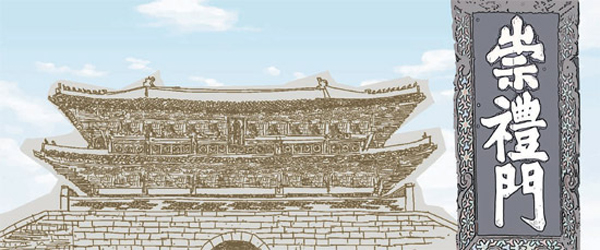A critical lack of accountability

I had toured Kanazawa Castle in Japan in June and Hwaseong Fortress in Suwon, Gyeonggi, in August with experts from various fields. The two cultural heritage sites have something in common: The names of the people who worked on the project were identified. As we looked around Hwaseong, we found the names of construction supervisors in each section engraved into the stone.
Park Seok-moo, director of the Dasan Institute and leader of the tour, said the marks tell us who was in charge of the section, and that the system was established in the 18th century during the reign of King Jeongjo. Park said it was a device to make the supervisor accountable for the mistakes and problems, and the system could be even more helpful today.
King Jeongjo was wise to implement such a logical idea, and Hwaseong still stands solid today. Kim Dae-sung, the architect of the Seokguram Grotto from the Unified Silla period (676-935), exerted his utmost efforts and prayed every day to create a brilliant treasure that has lasted more than 1,000 years. Why can’t we properly restore and maintain the 600-year-old Sungnyemun and the 1,000-year-old Seokguram with 21st-century technology?
Similarly, the rocks piled in front of Kanazawa Castle were engraved with various crests. Chungbuk University professor Kang Hyeong-gi explained that Taimyo Maeda had the warrior clans working on the castle’s construction and material procurement carve their family crests into the rocks. The leader wanted the samurai clans to take responsibility for the construction of their sections with their family honor. A guide said that when construction was not carried out properly, the supervisor in charge of the problematic section had to commit suicide by disembowelment.
The Kanazawa College of Art, which retrains people in traditional craftsmanship, was even more interesting. Established in 1996, the college continues nine traditional trades in masonry, roof tile, plastering work, building carpentry, tatami floor mats, windows, doors, sheet metal and ironwork. Mr. Kitaura, the chairman of the board of directors, told us that the college offers free three-year programs consisting of cultural studies, spiritual education, field trips, technical instruction, training and comprehensive hands-on experiences. The expenses are funded by the city and donations. When I asked why skilled craftsmen needed retraining, he responded that the spirit and skills of the master become even more impressive the more he trains. I wonder if there’s a school that teaches artisanship in leadership and administration.
*The author is an editorial writer of the JoongAng Ilbo.
by CHAE IN-TAEK
순간 말문이 막혔다. 2008년 2월 화마(火魔) 이후 5년3개월에 걸친 복원이 끝난 지 반년 만에 기둥이 갈라지고 단청이 떨어져 나간 국보 1호 숭례문 앞에 서니 고개를 들 수가 없었다. 문득 지난 6월 일본 가나자와(金澤)성과 8월 수원 화성을 각계 전문가들과 함께 살펴봤을 때가 떠올랐다. 두 곳은 전통문화재란 것 말고도 공통점이 또 있다. 공사 실명제다. 화성을 돌아보니 석재 곳곳에 희미하게나마 글씨가 각인돼 있었다. 일행을 이끈 박석무 다산연구소 이사장은 “해당 구간 공사 책임자가 누군지를 알려주는 표식”이라며 “18세기 정조 당시에 이미 공사실명제를 시행했던 것”이라고 설명했다. 박 이사장은 “문제가 생기면 표식을 보고 즉각 담당자를 가려내 책임을 물릴 수 있게 한 장치”라며 “오늘날에 더 필요한 제도가 아닌가 싶다”라고 일침을 놨다. 그 임금에 그 신하라고 이런 아이디어를 시행한 정조를 집주인으로 둔 작품답게 수원 화성은 오늘날에도 위용을 자랑한다. 통일신라 시대 석굴암 건축주인 김대성은 매일 절을 드리며 온갖 정성을 쏟아 1000년을 넘게 버틴 천하 명품을 만들지 않았는가. 600년 숭례문과 1000년 석굴암을 21세기를 사는 우리는 왜 제대로 복원·관리하지 못하는지. 가나자와 성도 마찬가지였다. 단단한 아름드리 바위를 성 입구에 쌓아놨는데 돌마다 서로 다른 문양이 선명했다. 동행한 충북대 강형기 교수(행정학)는 “다이묘(大名·대영주)인 마에다(前田)가 성을 보강하면서 각 구간의 석재 조달과 축성을 맡은 부하들의 가문 문장을 돌에 새기게 했다”며 “신하인 사무라이들에게 가문의 명예를 걸고 공사를 마무리하도록 책임지우기 위한 것”이라고 설명했다. 안내인의 설명에 따르면 만일 부실·졸속공사가 발견될 경우 해당 책임자는 할복으로 책임을 지는 것이 원칙이었다니 섬뜩할 따름이다. 관리와 행정에서도 목숨과 바꿀 정도로 치열한 ‘장인정신’을 요구한 셈이다. 더욱 흥미로웠던 건 전통 장인을 재교육하는 ‘가나자와 장인(일본어로는 쇼쿠닌(職人))대학교’였다. 1996년 설립돼 석공·기와·미장·정원·대공(집짓는 목수)·다다미·창호·판금·표구 등 9개 전통기술을 전승하고 인재를 육성하는 장인 교육기관이다. 이 대학의 기타우라(北浦) 이사장은 “교양강의·정신교육·견학체험·기술전수·연마·종합실습제작으로 이뤄진 3년 과정의 무료 프로그램”이라고 소개했다. 경비는 문화도시를 표방한 시의 지원과 시민 모금으로 충당한다고 한다. 장인의 경지에 올라도 재교육이 필요하냐고 물었더니 “장인 정신과 기술은 다듬으면 다듬을수록 더욱 빛이 나는 법”이라는 대답이 돌아왔다. 리더십과 행정에서 장인정신을 기르는 학교는 없을까 싶어 순간 말문이 막혔다. 채인택 논설위원










with the Korea JoongAng Daily
To write comments, please log in to one of the accounts.
Standards Board Policy (0/250자)